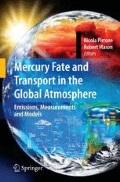Summary
A global atmospheric circulation model, ECHMERIT, with coupled meteorology and atmospheric chemistry including mercury has been developed. The model is designed to study in detail the atmospheric physical and chemical processes which influence the atmospheric lifetime of mercury, and therefore its global deposition patterns. ECHMERIT, based on the Global Circulation Model (GCM) ECHAM5 differs from most global mercury models in that the emissions, chemistry, transport and deposition are coupled on-line to the GCM. Many atmospheric chemistry models treat meteorological and chemical processes separately, in giving the meteorological conditions to the CTM in relatively coarse temporal resolutions. Their coupling in ECHMERIT avoids temporal and spatial interpolation, which permits more accurate representation of the interaction between chemical and meteorological phenomena, providing more highly resolved (temporal and spatial) meteorological fields. The coupling of the modules has been achieved in a modular way keeping the model as flexible as possible. This flexibility allows the model to be run with different levels of complexity. An example of a process for which a more detailed impact study could improve understanding of the atmospheric Hg cycle is biomass burning, which involves emission, reaction, gas-particle partitioning and deposition of Hg. At present ECHMERIT is being used within the HTAP Task Force to contrast and compare the performance of different models in a series of passive tracer transport experiments. Modelling experiments with extensive Hg chemistry, with both wet and dry deposition included, to assess the consequences of emission scenario changes for different Hg source areas are being evaluated.
Access this chapter
Tax calculation will be finalised at checkout
Purchases are for personal use only
Preview
Unable to display preview. Download preview PDF.
19.5 References
Aghedo A., Rast S. & Schultz M. G. (2008): Sensitivity of tracer transport to model resolution, forcing data and tracer lifetime in the general circulation model ECHAM5; Atmospheric Chemistry and Physics Discussions; Vol. 8: p. 137–160.
AMIP: http://www.pcmdi.llnl.gov/projects/amip/AMIP2EXPDSN/BCS/amip2bcs.php.
Calvert J.G. & Lindberg S.E. (2005): Mechanisms of mercury removal by O3 and OH in the atmosphere; Atmospheric Environment; Vol. 39: p. 3355–3367.
Damina-Iordache V., Sandu A., Damian-Iordache M., Carmichael G. R. & Potra F. A. (2002): The kinetic preprocessor KPP: a software environment for solving chemical kinetics; Computers Chemical Engineering; Vol. 26: p. 1567–1579.
Duncan B. N., West J. J., Yoshida Y., Fiore A. M., & Ziemke J. R. (2008): The influence of European pollution on ozone in the Near East and northern Africa; Atmospheric Chemistry and Physics Discussions; Vol. 8: p. 1913–1950.
Granier C., Guenther A., Lamarque J., Mieville A., Muller J., Olivier J., Orlando J., Peters J., Petron G., Tyndall G. & Wallens S. (2005): POET, a database of surface emissions of ozone precursors; techreport; available on the internet at: http://www.aero.jussieu.fr/projet/ ACCENT/POET.php.
Hall B. (1995): The phase oxidation of elemental mercury by ozone. Water, Air and Soil Pollution; Vol. 80: p. 301–315.
Kerkweg A., Buchholz J., Ganzeveld L., Pozzer A., Tost H. & Joeckel P. (2006): Technical Note: an implementation of the dry removal processes DRY DEPosition and SEDImentation in the Modular Earth Sumodel System (MESSy); Atmospheric Chemistry and Physics Discussions; Vol. 6: p. 6853–6901.
Lohman K., Seigneur C., Gustin M. & Lindeberg S. (2008): Sensitivity of the global atmospheric cycle of mercury to emissions; Applied Geochemistry;accepted for publication.
Pacyna E.G., Pacyna J.M., Steenhuisen F. & Wilson S. (2006): Global anthropogenic mercury emission inventory for 2000. Atmospheric Environment, Vol. 40 (22): p. 4048–4063.
Pal B. & Ariya P. (2004): Studies of ozone initiated reactions of gaseous mercury: kinetics, product studies, and atmospheric implications. Physical Chemistry Chemical Physics; Vol. 6: p. 572–579.
Pirrone N., Forlano L. & Hedgecock I.M. (2000): Role of the ambient aerosol in the atmospheric processing of semivolatile contaminants: a parameterized numerical model (Gas-Particle Partitioning (GASPAR)). Journal of Geophysical Research; Vol. 105(D8): p. 9773–9790.
Pongprueksa P., Lin C.-J., Lindberg S.E., Jang C., Braverman T., Bullock O.R., Ho T.C. & Chu H.-W. (2008): Scientific uncertainties in atmospheric mercury models III: Boundary and initial conditions, model grid resolution, and Hg(II) reduction mechanism; Atmospheric Environment; Vol. 42: p. 1828–1845.
Roeckner E., Baeuml G., Bonaventura L., Brokopf R., Esch M., Giorgetta M., Hagemann S., Kirchner I., Kornblueh L., Manzini E., Rhodin A., Schlese U., Schulzweida U., Tompkins A., (2003): The atmospheric general circulation model ECHAM5: Model description. Max Planck Institute for Meteorology, Technical Report, 349.
Schulzweida U., Kornblueh L. & Quast R. (2007): CDO User's Guide, Climate Data Operators, Version 1.0.7; techreport; www.mpimet.mpg.de/fileadmin/software/cdo/.
Seigneur C., Vijayaraghavan K. & Lohmann K. (2006): Atmospheric mercury chemistry: Sensitivity of global model simulations to chemical reactions; Journal of Geophysical Research – Atmospheres; Vol. 111, D22306, doi:10.1029/2005JD006
Seinfeld C. P. & Pandis S. N. (1998): Atmospheric Chemistry and Physics, From Air Pollution to Climate Change.
Slinn, W. G. N., (1982) Prediction for particle deposition to vegetative canopies. Atmospheric Environment; Vol.16: p. 1785–1794.
Wesely M. L. (1989): Parameterization of the surface resistances to gaseous dry deposition in regional-scale numerical models; Atmospheric Environment; Vol. 23: p. 1293–1304.
Wesely M. L. & Hicks B. B. (1977): Some factors that affect the deposition rates of sulfur dioxide and similar gases on vegetation; Journal of Air Pollution Control Assessment; Vol. 27: p. 1110–1116.
Yang X., Cox R.A., Warwick N.J., Pyle J.A., Carver G.D., O'Connor F.M. & Savage N.H. (2005): Tropospheric bromine chemistry and its impacts on ozone: A model study; Journal of Geophysical Research; Vol. 110, D23311, doi:10.1029/2005JD006244.
Zaveri R. A. & Peters L. K. (1999): A new lumped structure photochemical mechanism for large-scale applications; Journal of Geophysical Research; Vol. 104(D23): p. 30.387–30.415.
Author information
Authors and Affiliations
Editor information
Editors and Affiliations
Rights and permissions
Copyright information
© 2009 Springer-Verlag New York
About this chapter
Cite this chapter
Jung, G., Hedgecock, I.M., Pirrone, N. (2009). The ECHMERT model. In: Mason, R., Pirrone, N. (eds) Mercury Fate and Transport in the Global Atmosphere. Springer, Boston, MA. https://doi.org/10.1007/978-0-387-93958-2_19
Download citation
DOI: https://doi.org/10.1007/978-0-387-93958-2_19
Published:
Publisher Name: Springer, Boston, MA
Print ISBN: 978-0-387-93957-5
Online ISBN: 978-0-387-93958-2
eBook Packages: Earth and Environmental ScienceEarth and Environmental Science (R0)

